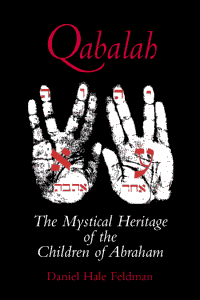




B. Description of the Book "QABALAH: The Mystical Heritage of the Children of Abraham"

The book is composed of seven chapters, an epilogue,
a glossary, and two appendices. The first chapter focuses on how the Mystical
Qabalah of the children of Abraham developed and took shape through successive
transmissions of the universal mystical spirituality by Adam, Abraham,
Mosheh (Moses), Yeshuvah (Jesus), and Muhammad. The ensuing discussion
addresses a number of basic questions:
What is the universal Mystical Qabalah of the children of Abraham?
In what ways is the Mystical Qabalah distinct from the Practical or Hermetic
Kabbalah?
In what ways is the Mystical Qabalah distinct from the Rabbinical Jewish
Kabbalah?
What is the relationship between the Mystical Qabalah and Mystical Christianity?
What is the relationship between the Mystical Qabalah and Sufism?
What are the similarities between the Mystical Qabalah and North Indian
Tantra?
Chapter One concludes with a comparison between the qabalistic teachings
regarding the Work of Creation (ma’aseh b’reshith) and
the Work of the Chariot (ma’aseh merkabah), and contemporary
ideas in modern scientific cosmology.
Chapter Two introduces and describes the primary textual sources of the
Mystical Qabalah of the children of Abraham. These sources include the
Sefer HaShmoth (Book of the Names); the Sefer
Yetzirah (Book of Formation); the Seferim HaTorah
(Books of the Law); the Sefer HaZohar (Book of
Splendor), and particularly its three core texts—the Sifra
Detzniyutha (Book of THAT Which is Concealed), the Idra
Rabba Qadusha (Greater Holy Assembly), and the Idra
Zuta Qadusha (Lesser Holy Assembly); Merkabah (lit. Throne)
literature, including the Seferim HaChanokh (Books of
Enoch son of Yared), the verses from the Books of Isaiah and
Ezekiel, and the Sh’ir Qoma (Measure of the
Divine Body from the Sefer Raziel HaGadol); the Peshitta
(Gospels) and the Revelation of John; the Qur’an;
and the Etz HaChayyim (Tree of Life). While many
would question including the Peshitta and Qur’an
as primary sources of the Mystical Qabalah, it is appropriate to include
them if one acknowledges that the Hebrew, Jewish, Christian, and Islamic
religions are progressive developments or branches of the same Shemite
Tree.
Chapter Three gives a thorough introduction to the core teachings of the
Mystical Qabalah. In this chapter, the reader will learn about the Ayn,
the negatively existent Mysterious Unknown at the Roots of All Things
and Its two Faces: Vast Face and Small Face. This is followed by an explication
of the nature and composition of the qabalistic Tree of Life, including
its roots, columns, Inner Court, Directional Sefiroth, and letter-gates.
The Tree of Life is a central feature of the mystical tradition that lies
at the heart of the ancient Hebrews. Among students of Qabalah, there
is considerable confusion about the Tree. This is due in no small measure
to the many books on the subject that present various hybrid versions
of the Tree, and attribute to the Tree a wide range of occult and mythological
information not based in the qabalistic tradition. Hermetic Qabalists
will find notable differences between the way the Mystical Qabalah correlates
the Hebrew letters with the Gates on the Tree and those commonly seen
in occult books on the subject. The Tree provides a map through the four
qabalistic worlds and the shells of embodied existence (qlifoth),
which are addressed in successive sections in this chapter. The Tree also
portrays what the first book of the Torah describes as the
“Fall of Adam,” which is then discussed in detail within the
context of qabalistic teachings. The information that is provided up to
this point in the chapter serves as a suitable backdrop to introduce the
Divine Name hvhy, which is of singular importance in qabalistic practices,
and to discuss the nature of messianic appearance within the context of
the qabalistic teachings.
Chapters Four and Five contain extensive information and a singularly
comprehensive collection of Tree of Life diagrams culled from all of the
primary texts. As a useful comparison, Chapter Five examines some Trees
of Life from other mystical traditions, including the Chakras of the Tantric
tradition, and the “Before-the-World Sequence” of Trigrams from
the Shuo Qua, the eighth and oldest wing of the Chinese
I Ching (Book of Changes). With a solid foundation of core
ideas regarding the qabalistic worldview and a thorough orientation to
the nature of qabalistic practices under the reader’s belt, Chapter
Six presents a wealth of information in preparation for engaging in the
meditation practices of the Mystical Qabalah. This chapter also draws
some interesting analogies relating qabalistic ideas, the neurology of
the human brain, and cybernetics. The theoretical infrastructure provided
in Chapter Six is then followed directly in Chapter Seven by detailed
instructions on how to actually perform the primary qabalistic meditation
practices. This chapter also describes a variety of valuable ancillary
practices that might be used to complement a daily routine of qabalistic
meditation.
The main body of the text closes with an epilogue containing some final
observations on the study and practices of the Mystical Qabalah, and a
brief discussion of the idea of “Hebrew Renewal” i.e. a return
to the religion of Abraham. Appendix A contains the complete listing of
the Divine Names in the Sefer HaShmoth (Book of Names).
Appendix B applies the ideas of modern scientific cosmology to the qabalistic
model of the Work of Creation (ma'ase bareshith). The appendices
are followed by a glossary of terms.
Disclaimer
The information in this book is intended for educational purposes only.
Readers who elect to engage in the practices and disciplines described
herein do so at their own discretion and liability.